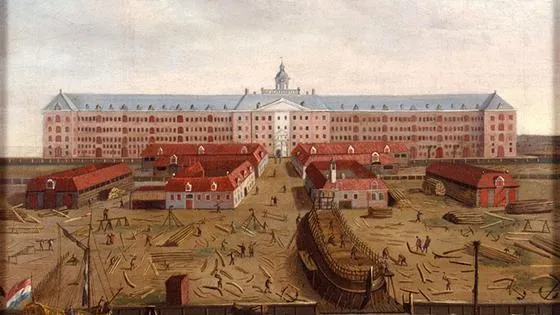The Dutch East India Company had a total of six shipyards: Amsterdam, Hoorn, Enkhuizen, Delft, Rotterdam and Middelburg. But the largest and most important by far was Amsterdam. Some half of the tonnage of all East India Company ships built between 1602 and 1799 came together here. An East Indiaman took a year and a half to build, and each year three such ships sailed out of Amsterdam.
A manmade island in Amsterdam
By the mid-17th century, the East India Company was growing out of its digs in Amsterdam; the old shipyard at Rapenburg had become much too small. In 1661, the company purchased the new, manmade island of Oostenburg on the River IJ. That year, the company took delivery of its enormous sawmill and a 500-metre-long ropemaking line. These were the first components of what was to become, in its time, the largest industrial operation in the world. Three huge slipways were built on the waterside. The East India Company moved into Oostenburg in 1665.
A storehouse filled with spices
Perhaps the island's most impressive feature was the company's storehouse. Four storeys high, the Oost-Indisch Zeemagazine was designed by Daniël Stalpaert, who had previously designed the admiralty's vast storehouse 's Lands Zeemagazijn (Todays Scheepvaartmuseum/Maritime Museum). The East India Company storehouse was 177 metres long, 20 metres wide and 22.5 metres from floor to ceiling, filled with priceless and aromatic goods from Asia. Its facilities included a slaughterhouse downstairs and a sailmaker's in one of the attics. Behind the huge storehouse were the workshops, sheds and other buildings of the East India Company. One important building was the wood oven, where the planks that went into the ships were shaped. This building was placed at a safe distance from the other buildings, alongside the water.

The East India Company´s Sea storehouse, designed by Daniël Stalpaert
Collapsed under the heavy load
The foreman of the shipyard, the quartermaster, lived on site, in the large foreman's residence. The other employees, some 1,300 shipwrights, carpenters, pulley-makers, smiths and sailmakers lived nearby. When the East India Company was dissolved in 1799, the Oost-Indisch Zeemagazijn was used as a grain storage depot. Neglect combined with the heavy loads stored in it led to the building's collapse in 1822. It was never rebuilt.